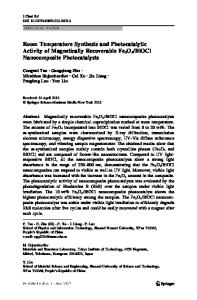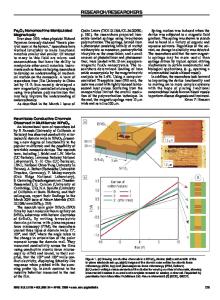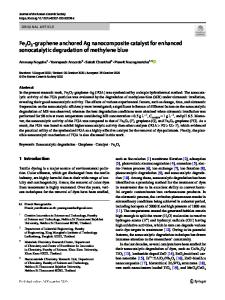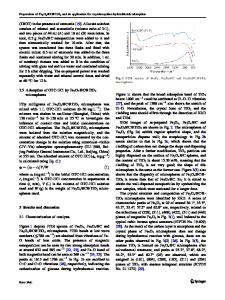Effective and magnetically recoverable TiO 2 /Fe 3 O 4 /AgI nanocomposite for degradation dye pollutants under visible l
- PDF / 4,547,555 Bytes
- 12 Pages / 595.276 x 790.866 pts Page_size
- 25 Downloads / 327 Views
Effective and magnetically recoverable TiO2/Fe3O4/AgI nanocomposite for degradation dye pollutants under visible light illumination Soheila Gholamian2 · Mitra Mousavi1 · Abdolhadi Farokhnia2 · Majid Hamzehloo1 Received: 13 May 2020 / Accepted: 28 July 2020 © Springer Science+Business Media, LLC, part of Springer Nature 2020
Abstract In this research work we report on the preparation of T iO2/Fe3O4/AgI multicomponent photocatalysts for decontamination of various organic dyes via photocatalysis process under visible illumination. The chemical and physical features of the prepared photocatalysts were characterized by XRD, UV–Vis DRS, SEM, EDX, FT-IR, BET, VSM, and PL analyses. The TiO2/Fe3O4/AgI (30%) photocatalyst displayed the highest photodegradation ability for RhB, Eosin-Y, and fuchsine, which was about 75.3, 35.3, 21.8-times greater than that of the T iO2, 26.2, 20.8, and 10.5-folds as high as that of the T iO2/Fe3O4 samples, respectively. This improved photocatalytic activity is related to the formation of n–n heterojunction between two semiconductor, broader visible light spectrum response, and diminished charge carriers recombination. Scavenging experiments confirmed that the .O2−, h+, and .OH are reactive species in RhB photodegradation process. Moreover, the TiO2/Fe3O4/ AgI (30%) nanocomposite exhibited greatly stable recycling activity. Finally, a plausible photocatalytic mechanism has been proposed based on the experimental results. This research suggests a facile method to design the magnetically separable nanocomposites based on TiO2 with significant photoactivity under visible irradiation.
1 Introduction The rapid industrialization of human societies and the dependence of these industries on fossil fuel resources have aggravated the global energy crisis and caused a range of environmental problems [1–3]. Thus, development of renewable energy sources that can replace fossil fuels has attracted scientific attentions [4]. Solar energy is renewable, clean, and unceasing, so developing ways to efficiently use of this energy source is essential [5, 6]. On the other hands, the environmental pollution resulting from this industrialization and change of lifestyle caused many problems to the human health and ecological safety [7, 8]. Recently, heterogeneous photocatalysis, as one of the most favorable manners of advanced oxidation processes, have attracted widespread interests to address energy and environmental problems [9, 10]. As known, photocatalysis are based on semiconductors [11, 12]. * Majid Hamzehloo [email protected] 1
Department of Physical Chemistry, School of Chemistry, College of Science, University of Tehran, Tehran, Iran
Department of Chemistry, Faculty of Science, University of Shahid Chamran, Ahwaz, Iran
2
Among different semiconductors, titanium dioxide (TiO2) has been considered as a well-known n-type promising semiconductor due to its some advantages including nontoxicity, significant chemical stability, hydrophilicity, superior oxidizability, water insolubil
Data Loading...











